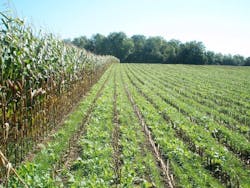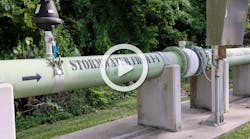How the Agricultural Non-point Source Abatement & Control Program Addresses Water Quality
About the author:
Bethany Bzduch is Ag NPS program manager for the NYS Department of Agriculture and Markets, Division of Land and Water Resources. Bzduch can be reached at [email protected].
Protecting surface and groundwater resources, including sources of public drinking water, has been an important and long-standing objective in New York State. Working with the New York State Soil and Water Conservation Committee and County Soil and Water Conservation Districts (SWCDs), New York state has been using the Agricultural Nonpoint Source Abatement and Control Grant (Ag NPS) Program to work towards these goals for nearly three decades. Over the years, the program has seen the successful implementation of more than 300 projects on 2,000 farms across the state that abate and control non-point source pollution from both agricultural and non-agricultural sources, conserve waterways and reinvest in the agricultural industry in New York.
Non-point source pollution can come from many different sources, such as fertilizer and pesticide applications, manure spreading, timber harvesting, construction and road salt applications and occurs when rain or snowmelt runoff deposits contaminates into waterbodies. These sources of pollution can have a significant impact on water quality and wildlife and aquatic habitats and pose serious health risks to humans.
In an effort to mitigate these issues, the Ag NPS Program, which is funded through the New York State Environmental Protection Fund (EPF), provides cost share assistance to New York state farmers for projects that prevent water pollution and support New York’s diverse agricultural community in its broader efforts to reduce non-point source pollution.
Program funds are available for a variety of objectives, including farms that wish to develop Comprehensive Nutrient Management Plans (CNMPs). To create a CNMP, a certified planner evaluates all aspects of a farm’s operation and then offers conservation practices that help achieve production and natural resource conservation goals for the farm. These plans are required for Concentrated Animal Feeding Operations (CAFOs) that are regulated by New York state but can be developed and implemented by any livestock farm operation.
Program funds are also available to implement eligible agricultural best management practice (BMP) systems on state farms. A BMP system consists of one or more individual conservation practice standards, as defined by the United States Department of Agriculture Natural Resource Conservation Service (NRCS). These systems are designed to prevent, reduce or treat the source or transport of potential contaminants originating from agricultural activities. County SWCDs are at the forefront of this work, partnering with farms to identify appropriate BMP systems to address specific environmental risks while maintaining the goals of the farm. Interested farms will work with their local SWCD to become involved in the Agricultural Environmental Management (AEM) Program. AEM is a voluntary program that helps farmers make management decisions that will meet their business objectives, promote environmental stewardship and conserve New York’s natural resources.
Through the AEM Program, SWCDs will conduct environmental risk assessments and develop conservation plans that are specific to each farm operation. A typical conservation plan will include suggested BMP systems to address resource concerns and reduce environmental risk. Once a plan is developed, a farm can apply to the Ag NPS Program for financial assistance to carry out implementation.
A variety of BMP systems are supported through the Ag NPS Program. Eligible systems can include those that involve changes in farm management, increase the amount of vegetation on critically eroding areas and along stream banks, or control surface runoff of agricultural pollutants through structural practices. One common best management practice system that is funded through the program is the Prescribed Rotational Grazing System. This system assists farmers in developing a network of paddocks that are grazed by livestock on a rotating basis, which prevents soil erosion from denuded paddocks, reduces water runoff and promotes healthy soil. Other systems that specifically promote soil health are also supported by the program. These include practices that control soil erosion, reduce runoff and enhance soil health, helping to limit the loss of soil from cropland, pastures, orchards, vineyards and more. A typical soil health system will include practices, such as cover cropping, reduced tillage practices, mulching and crop rotation. More and more farms are realizing the multitude of benefits soil health systems can provide. Through the Ag NPS Program, nearly 90,000 acres of cover crops have been funded.
Structural systems, such as a Silage Leachate Treatment System and Waste Storage and Transfer System, can also be funded through the program. Silage is a common source of feed used on farms. Leachate containing high concentrations of nutrients and acid can be produced when silage is stored. If allowed to enter surface waters, silage leachate can greatly harm aquatic habitats. The Ag NPS Program provides funding for a number of practices that can properly collect and treat leachate from silage. Nutrient management is another critical piece to a farm’s operation. Having the ability to store manure enables a farm to recycle valuable nutrients back to the land under the right conditions at agronomically responsible rates. Manure storage facilities and associated practices are supported through the program to reduce the loss of surface and subsurface nutrients, improve nutrient management and promote soil health.
New York State’s Ag NPS Program has long been recognized as one of the keystone non-point source pollution abatement programs in the state and nationwide. In 1994, the first round of the grant program awarded approximately $350,000 to ten farms. Since then, funding support for this program has grown exponentially, providing a greater opportunity to reach more farms in high priority watersheds. In 2021, the 26th round of the Ag NPS Program awarded nearly $15 million to 147 farms.
To date, the program has addressed water quality concerns in over 600 sub-watershed basins (12-Digit Hydrologic Units) across the state and has assisted over 2,000 farms in protecting the quality of water resources in their communities. Continual support for this program not only allows water quality issues to be addressed, it also reinvests state resources back into one of the top economic engines in New York State: agriculture. In New York, the agricultural industry is responsible for generating billions of dollars each year. Thousands of farms statewide produce a wide variety of products, including dairy, fruits, vegetables, maple syrup and wine and juice grapes.
Water is necessary for the survival of all living things and the importance of ensuring that the current supply of fresh water remains intact cannot be overstated. In addition to maintaining the availability of water supplies, it is critical that we protect water supplies from becoming polluted. Limiting the potential for pollutants to enter surface or ground water resources results in a higher volume of fresh water that is available and safe to use. Agricultural practices that reduce the generation of contaminates and prevent their transport can have a positive impact on water quality if applied and managed appropriately. The Agricultural Nonpoint Source Pollution Abatement and Control program makes it possible for farms to practice environmental stewardship and to do their part in protecting and conserving critical water resources.


